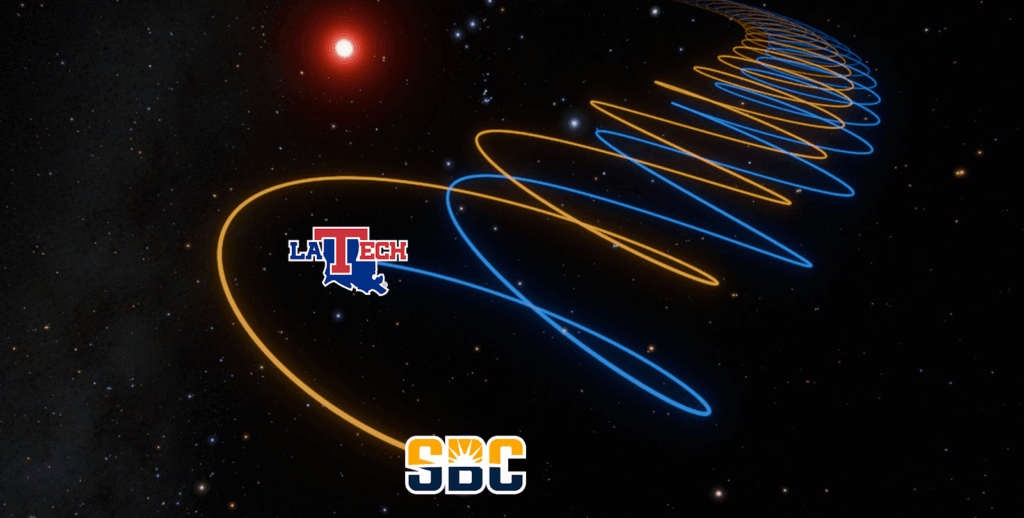Yesterday, the Sun Belt voted to throw Louisiana Tech a life raft. After decades of chasing prestige in other leagues and believing that the program was far above others like Louisiana-Lafayette and Arkansas State, the school turned to them to escape a sinking Conference USA.
But this isn’t a completely new partnership. Tech and the Sun Belt have crossed paths before, both directly and through shared chaos. And to understand why this reunion makes sense, you have to rewind several decades.
Let’s set the stage: It’s 1987. The Iran-Contra affair is in the headlines. The Simpsons makes their debut on the brand new Fox Network. And nearly as importantly, Louisiana Tech leaves the Southland Conference.
The Southland, now home to schools like Northwestern State and Southeastern, had been Tech’s home throughout the ’70s and into the early ’80s. But after the league dropped to Division I-AA (now FCS) football in 1982, Tech began charting a course back to Division I-A (FBS).
Louisiana-Lafayette had already made a similar move, leaving the Southland during its relegation in 1982 and staying in Division I-A (FBS) as an independent. But leaving the Southland was an all-or-nothing ordeal and without another conference to jump to, UL-L had to go fully independent across all sports.
That isolation took a toll. The Cajuns had to scramble to put together schedules, postseason opportunities disappeared, and exposure was limited.
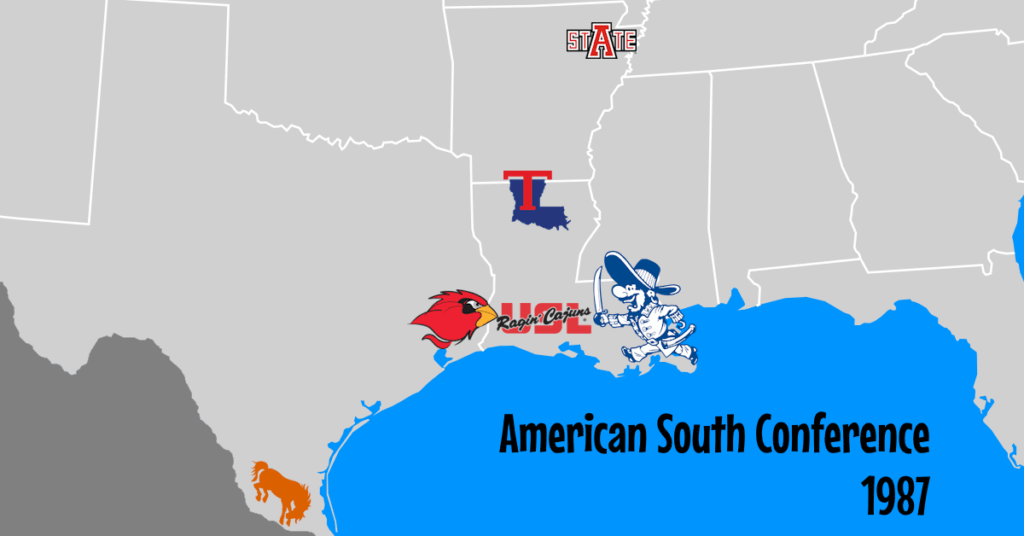
So when Tech leaves the Southland, they need a conference for their non-football sports. Teaming up with UL-L, Arkansas State, and Lamar, Louisiana Tech helped found the American South Conference. To hit the NCAA-required minimum of six members, the conference added New Orleans and Texas–Pan American, schools without football programs.
In 1988, Tech (now a Division I-AA independent) began its transition back to Division I-A (FBS). The journey wasn’t easy—the 1988 schedule was so grueling that a bronze bulldog statue to commemorate that season stands in the south endzone. The next year, the Bulldogs put together a winning season that started with a victory over UL-L. And in the year following, Tech went 8-3-1 and tied Maryland in the Independence Bowl.
Everything from Tech’s perspective was trending upwards. Meanwhile, the Sun Belt was falling apart.
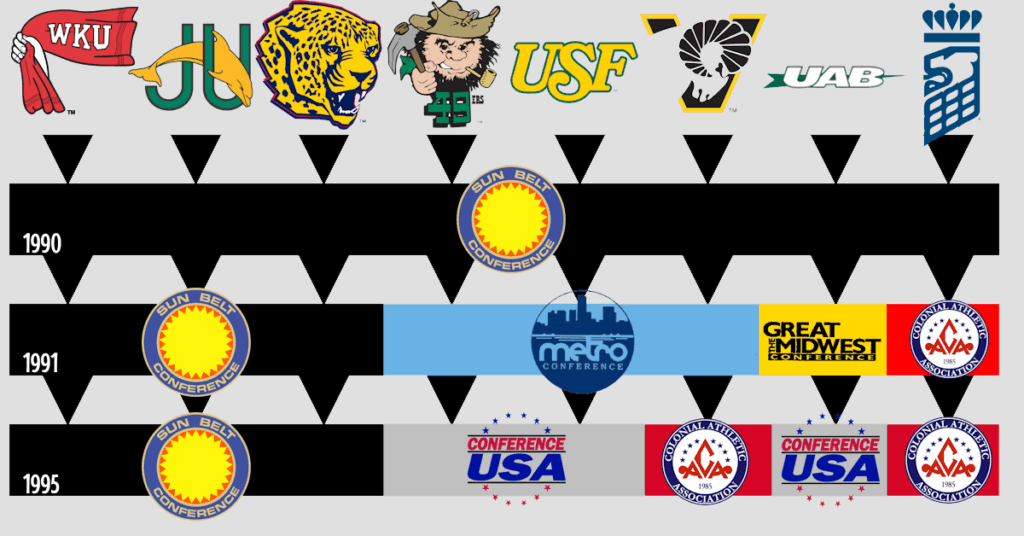
UAB, the basketball powerhouse in the league, left the Sun Belt to help found the Great Midwest Conference alongside schools like Marquette and DePaul. Memphis, Cincinnati, and St Louis left the Metro Conference to join them. In response, the Metro Conference poached Charlotte, South Florida, and VCU from the Sun Belt to plug the holes.
Five years later, the Great Midwest Conference and Metro Conference would merge to become Conference USA, really poking at the futility of it all.
To survive, the diminished Sun Belt merged with Tech’s home, the American South Conference, in 1991. The Sun Belt is dead, long live the Sun Belt.
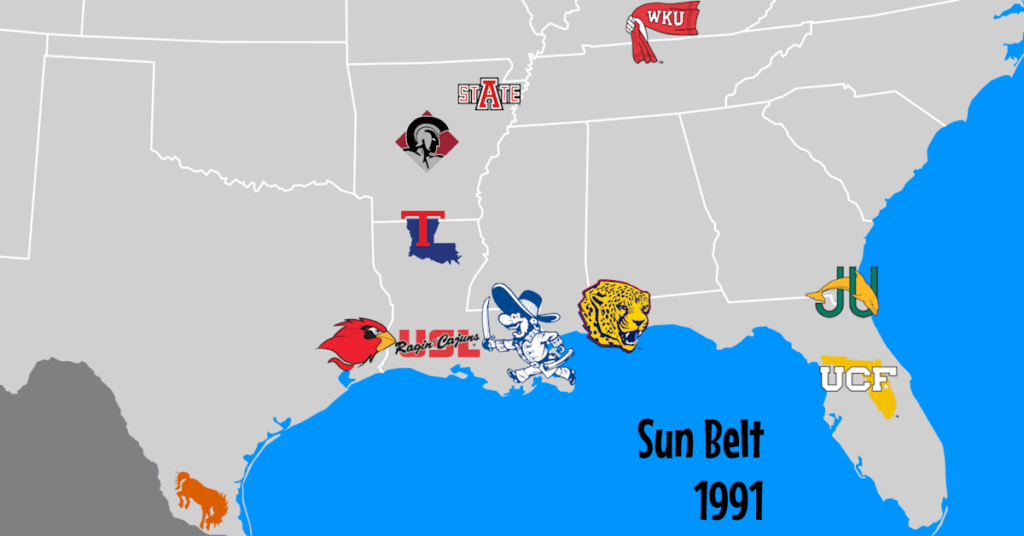
The early ’90s were relatively stable for the newly expanded Sun Belt. Central Florida, who had just joined the American South a year before the merger, left a year into the Sun Belt era, but the conference stayed stable at ten schools until 1998. But that’s when the chaos reignited.
UT-Pan American was sanctioned so harshly and repeatedly by the NCAA that the Sun Belt voted the school out before their basketball program could receive a death penalty. Lamar, now the only Texas school in the Sun Belt, left to rejoin the Southland. And Jacksonville left for similar reasons, as the Dolphins were the only Sun Belt school in the Eastern Time Zone.
The Sun Belt, now down to six members, scrambled to find new additions. In 1998, the Sun Belt added Florida International, and the next year, they added Denver.
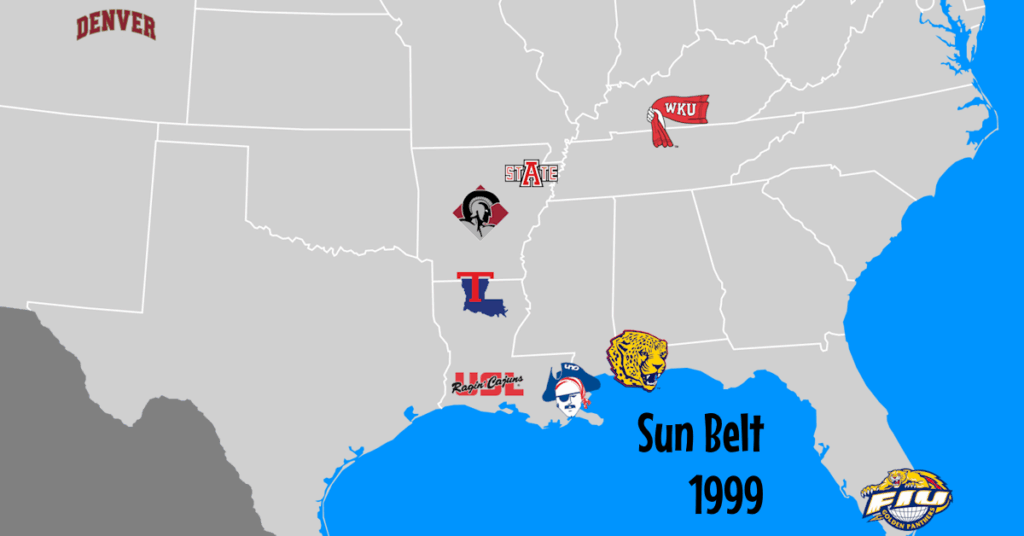
Geographically? A nightmare. Jacksonville had just left citing distance and travel costs—and FIU was even farther away.
In terms of our decision to leave the Sun Belt, I felt that the TAAC was on the rise, and the Sun Belt was on the downsizing. Geographically, the Sun Belt didn’t fit for us. There was more missed class time, and our fans didn’t have name recognition with our opponents. Louisiana Tech didn’t mean anything to our fans. FIU will face all those same issues.
Tom Seitz, Jacksonville University Athletic Director
At this point, the Sun Belt is still a non-football conference with three of their member schools (Louisiana Tech, Louisiana-Lafayette, and Arkansas State) playing as Division I-A (FBS) independents.
But with the conference still needing to expand, commissioner Wright Waters looked to add schools with football programs to allow the Sun Belt to add the sport. As money starts to flow into programs via media rights deals, Waters knew that adding football would also allow for the league to secure a much better TV contract.
But while the Sun Belt was trying to stay afloat, the Western Athletic Conference (WAC) was attempting to become a “super conference.” The ten team league looked to take advantage of the breakup of the Southwest Conference by adding name brand schools in TCU, SMU, and Rice. Then, to try to ease the growing footprint of the conference, added UNLV, San Jose State, and Tulsa to get to 16 teams.
This “super” conference led to a “super” amount of infighting about the geographic footprint that led to the presidents of half of sixteen schools to meet at the Denver airport and split into their own conference – the Mountain West. TCU, seeing the writing on the wall, soon left for Conference USA.

Needing to replenish its ranks, the WAC added Nevada to get back to eight schools. To get to ten, they looked to add one school in the west (Boise State) and one in the east – close enough to Rice, SMU, and Tulsa to make sense geographically.
So, in the summer of 1999, Louisiana Tech took the WAC’s offer for a 2001 admission.
For Tech, the WAC was far more lucrative than their current home. The Sun Belt hadn’t yet completely figured out how to get football off the ground. With new additions like FIU and Denver, the Sun Belt wasn’t much more “regional” than the WAC anyway. And let’s not forget about money and prestige:
By just being a member of the WAC, our NCAA revenue share will be twice what it is in the Sun Belt because of the number of teams that participate in the basketball championship every year
Jim Oakes, Louisiana Tech Athletic Director
Tech’s departure didn’t stop the Sun Belt from launching football. They invited MTSU, New Mexico State, and North Texas as full members and brought in ULM as a football-only participant.
Meanwhile, the WAC actually worked for Tech… at first. The WAC regularly sent two teams to the NCAA men’s basketball tournament while the Sun Belt only sent one. Bowl season regularly featured between two and four WAC schools while the Sun Belt only had one spot for its champion in the New Orleans Bowl. For a while, the move looked like a smart one.
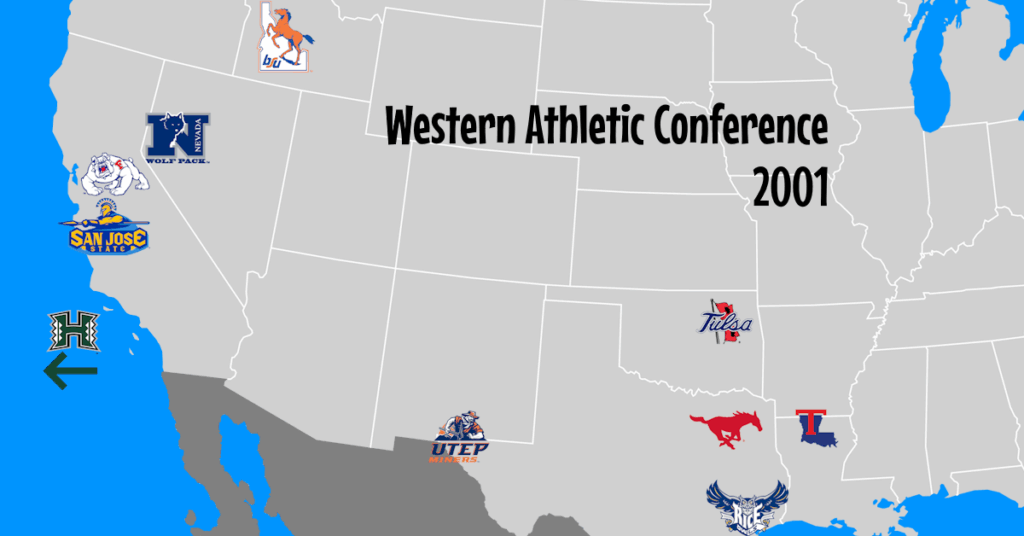
But realignment struck again. By 2006, Rice, SMU, and Tulsa, the Texoma trio that helped justify Tech’s WAC jump, left for Conference USA. Suddenly, Tech was geographically marooned. The closest conference opponent? Las Cruces, New Mexico. The next? Just under 2,000 miles away in Logan, Utah.
Still chasing prestige and old conference mates, Louisiana Tech joined C-USA in 2013… just as SMU left for the AAC. Tulsa followed the next year.
Pull back far enough, and the pattern becomes obvious. Schools jump to new conferences for money and prestige. Conferences backfill with awkward fits. Eventually, everyone remembers that geography and tradition matter.
If this were a children’s book, the lesson would be to know who you are.
Louisiana Tech does not have political pull like LSU. It’s not rich like SMU. It’s not in a major metro like TCU.
What Tech does have is history, tradition, and natural rivalries across the southeastern U.S.
Before Tech left the Southland in 1987, the program stood alongside Louisiana-Lafayette, Arkansas State, and Lamar. The Cardinals took an early retreat to the Southland. But the other three are finally reunited, again, in the Sun Belt.
It’s not a step back. It’s a return to something that always made sense.

